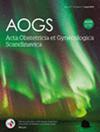Assessment of novel sonographic and biochemical tools for spontaneous preterm birth prediction in asymptomatic twin pregnancies
Abstract
Introduction
Prematurity is a major global health issue. Twin pregnancies are a group at especially high risk of preterm birth. Sonographic mid-trimester cervical length has limited accuracy in predicting preterm birth. This study aimed to evaluate the association between mid-trimester sonographic markers of early cervical remodeling and cervical inflammatory biomarkers and fetal fibronectin, alone or in combination, as predictors of preterm birth before 34+0 weeks in asymptomatic twin pregnancies.
Material and Methods
Prospective cohort study, including uncomplicated dichorionic or monochorionic-diamniotic twin pregnancies, recruited and assessed between 18+0 and 24+6 weeks, from a single tertiary referral center between 2020 and 2023. At inclusion, transvaginal ultrasound was performed to assess the following sonographic markers (cervical length, uterocervical angle, cervical consistency index, cervical texture) and an endocervical sample was obtained prior to ultrasound to quantify the following cervical inflammatory biomarkers (tumor necrosis factor alpha, interleukins 1b, 6, 8, 18, matrix metalloproteinase-8 and 9) and fetal fibronectin. The diagnostic performance of those sonographic and biochemical markers independently associated with spontaneous preterm birth before 34 weeks was analyzed by receiver operating characteristic curves and assessed through sensitivity and specificity analysis for several cutoffs.
Results
Of the 172 women included, cervical length was shorter (36 mm vs. 40 mm; p = 0.025) and uterocervical angle was wider (137° vs. 120°; p = 0.004) in the preterm group. Cervical consistency index, cervical texture score, cervical inflammatory biomarkers, and fetal fibronectin were similar among the study groups. The area under the curve to predict spontaneous preterm birth before 34+0 weeks was 0.722 (95% CI 0.577 to 0.866) for cervical length, 0.789 (95% CI 0.683 to 0.895) for uterocervical angle, and 0.852 (95% CI 0.752 to 0.952) for a combination of both. Based on the receiver operating characteristics curve cutoff, sensitivity and specificity for cervical length ≤37 mm was 55.6% and 66.3%, for an uterocervical angle ≥135° was 77.8% and 76.1%, and for both criteria present 44.4% and 93.3%, respectively.
Conclusions
This finding of this study suggests that the combination of cervical length and uterocervical angle in mid-trimester sonographic assessment may improve the prediction of preterm birth before 34 weeks in asymptomatic and uncomplicated twin pregnancies.


 求助内容:
求助内容: 应助结果提醒方式:
应助结果提醒方式:


